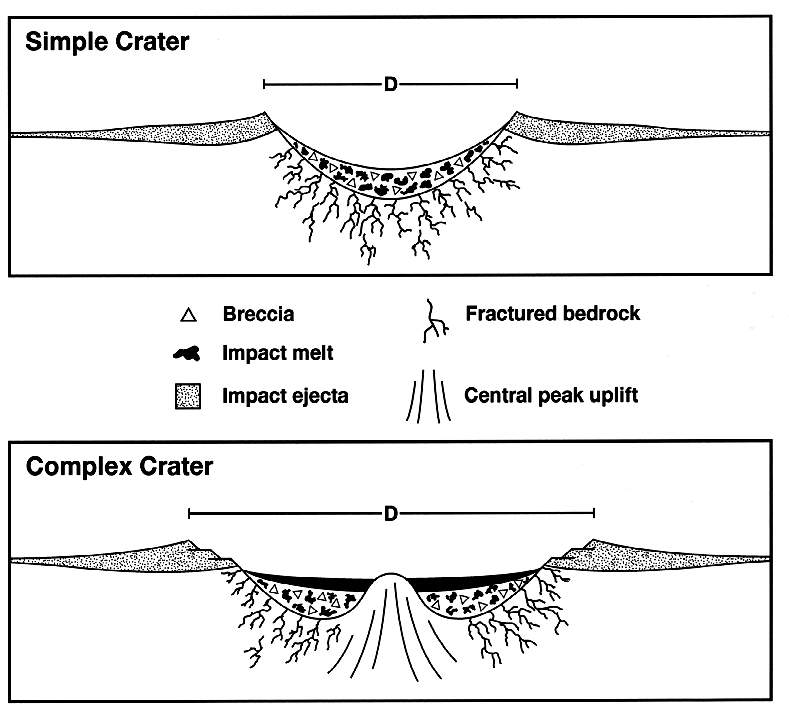
Impact structure
Encyclopedia

Impact crater
In the broadest sense, the term impact crater can be applied to any depression, natural or manmade, resulting from the high velocity impact of a projectile with a larger body...
or meteorite impact crater, and is used in cases where erosion or burial have destroyed or masked the original topographic feature with which we normally associate the term crater. This is the fate of almost all old impact craters on Earth
Earth
Earth is the third planet from the Sun, and the densest and fifth-largest of the eight planets in the Solar System. It is also the largest of the Solar System's four terrestrial planets...
, unlike the ancient pristine craters preserved on the Moon
Moon
The Moon is Earth's only known natural satellite,There are a number of near-Earth asteroids including 3753 Cruithne that are co-orbital with Earth: their orbits bring them close to Earth for periods of time but then alter in the long term . These are quasi-satellites and not true moons. For more...
and most other rocky bodies in the Solar System
Solar System
The Solar System consists of the Sun and the astronomical objects gravitationally bound in orbit around it, all of which formed from the collapse of a giant molecular cloud approximately 4.6 billion years ago. The vast majority of the system's mass is in the Sun...
. Impact structure is synonymous with the less commonly used term astrobleme meaning "star wound".
In an impact structure, the typical visible and topographic expression of an impact crater are no longer obvious. Any meteorite
Meteorite
A meteorite is a natural object originating in outer space that survives impact with the Earth's surface. Meteorites can be big or small. Most meteorites derive from small astronomical objects called meteoroids, but they are also sometimes produced by impacts of asteroids...
fragments that may once have been present would be long since eroded away. Possible impact structures may be initially recognized by their anomalous geological
Geology
Geology is the science comprising the study of solid Earth, the rocks of which it is composed, and the processes by which it evolves. Geology gives insight into the history of the Earth, as it provides the primary evidence for plate tectonics, the evolutionary history of life, and past climates...
character or geophysical
Geophysics
Geophysics is the physics of the Earth and its environment in space; also the study of the Earth using quantitative physical methods. The term geophysics sometimes refers only to the geological applications: Earth's shape; its gravitational and magnetic fields; its internal structure and...
expression. These may still be confirmed as impact structures by the presence of shocked minerals (particularly shocked quartz
Shocked quartz
Shocked quartz is a form of quartz that has a microscopic structure that is different from normal quartz. Under intense pressure , the crystalline structure of quartz will be deformed along planes inside the crystal...
), shatter cone
Shatter cone
Shatter cones are rare geological features that are only known to form in the bedrock beneath meteorite impact craters or underground nuclear explosions...
s, geochemical
Geochemistry
The field of geochemistry involves study of the chemical composition of the Earth and other planets, chemical processes and reactions that govern the composition of rocks, water, and soils, and the cycles of matter and energy that transport the Earth's chemical components in time and space, and...
evidence of extraterrestrial
Outer space
Outer space is the void that exists between celestial bodies, including the Earth. It is not completely empty, but consists of a hard vacuum containing a low density of particles: predominantly a plasma of hydrogen and helium, as well as electromagnetic radiation, magnetic fields, and neutrinos....
material or other methods.
See also
- complex craterComplex craterComplex craters are a type of large impact crater morphology.Above a certain threshold size, which varies with planetary gravity, the collapse and modification of the transient cavity is much more extensive, and the resulting structure is called a complex crater...
- Traces of CatastropheTraces of CatastropheThe book Traces of Catastrophe: A Handbook of Shock-Metamorphic Effects in Terrestrial Meteorite Impact Structures, or more commonly shortened to Traces of Catastrophe, was written by Bevan M. French of the Smithsonian Institution. It is a comprehensive technical reference on the science of impact...
book from Lunar and Planetary InstituteLunar and Planetary InstituteThe Lunar and Planetary Institute is a scientific research institute dedicated to study of the solar system, its formation, evolution, and current state. The Institute is part of the Universities Space Research Association and is supported by the Science Mission Directorate of the National...
- comprehensive reference on impact crater science - Earth Impact DatabaseEarth Impact DatabaseThe Earth Impact Database is the authoritative source for information on confirmed impact structures or craters on Earth. It was initiated in 1955 by the Dominion Observatory, Ottawa, under the direction of Dr. Carlyle S. Beals...
- impact eventImpact eventAn impact event is the collision of a large meteorite, asteroid, comet, or other celestial object with the Earth or another planet. Throughout recorded history, hundreds of minor impact events have been reported, with some occurrences causing deaths, injuries, property damage or other significant...
External links
- Terrestrial Impact Craters at the Lunar and Planetary Institute

